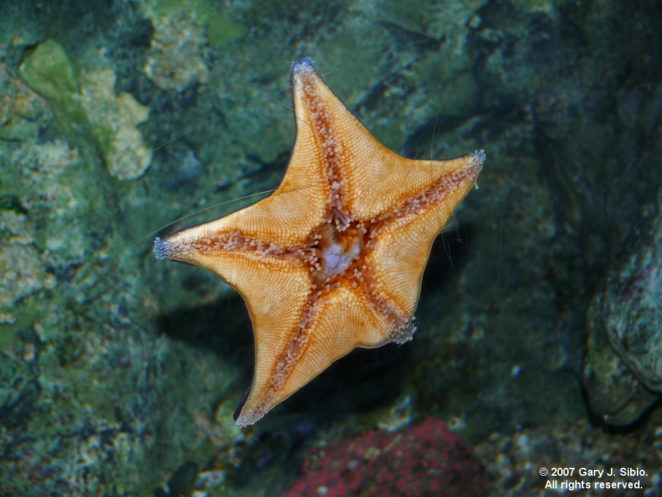Living in Chicago, Illinois, 1,000 miles away from the nearest ocean or sea, I have very little chance to photograph starfish. Fortunately, the Brookfield Zoo had some on display at an exhibit on the animals of the Pacific Coast of South America. That is where I took these photos.
#1
Starfish (2007-09-03 11-18-09a)
Starfish are aquatic, oceanic animals, but they are not fish. Instead they belong to the phylum Echinodermata, a word which comes from the Greek meaning "skin like a hedgehog" which, due to their rough, protective skin, is extremely appropriate.
There are between 1,500 and 2,000 species of starfish in the world depending on which expert you ask. All live in salt water but they can be found at a variety of depths ranging from tide pools to 20,000 feet (roughly 6,000 meters.) They are found in a wide variety of temperatures as well, ranging from tropical to frigid waters. They also come in a wide range of sizes as well. The smallest measure about half an inch while the largest reach about four feet in diameter.
Starfish are the most easily recognizable marine invertebrates (animals which do not possess a backbone). As the name implies, they look like stars with five "arms" extending from a central hub. Some starfish actually have more than five arms, as many as forty or fifty, but the number is almost always a multiple of five. The exception to the rule is the Seven-armed Starfish (Luidia ciliaris) which, as the name implies, has seven arms. Starfish occasionally loose arms but they can regrow a missing one. Sometime a regrowing arm will split and one arm will be replaced by two.
#2
Starfish 2 (2007-09-03 11-20-11a)
Their "feet" are the little tube-like structures on the underside of their arms. They use them to move along the sea floor looking for other invertebrates to eat. Their mouths are located on the underside of the hub. When they eat they turn their stomachs inside out through the mouth.
Starfish do not have well-defined sensory organs. Despite this they are sensitive to touch, light, temperature, orientation and the water conditions around them. Their tube feet (the ones under the arms), their spines and pedicellariae (small structures thought to keep the starfish clean of algae) are sensitive to touch.
Starfish have no brains but they do have a complex nervous system consisting of a ring of nerves around the mouth and nerves running out each of their arms. There is an eye-spot at the end of each arm but they don't see as we do. Their circulatory system consists of a heart which beats about six times a minute and three sets of blood vessels which form a ring around the mouth, the digestive system of the genitals.
Starfish have separate male and female individuals but they can't be distinguished when they are not mating. Some are hermaphroditic. One species, Asterina gibbosa, starts off life as a male but changes into a female as it ages. A few species fertilize the eggs internally but the vast majority do so externally.
#3
Starfish 5 (2007-09-03 11-22-18a)
Sources
Kennedy, Jennifer. About.Com Marine Life: 10 Facts About Starfish (Sea Stars)
Wikipedia: Starfish
Text © 2017 Gary J. Sibio. All rights reserved.
Photos © 2007 Gary J. Sibio. All rights reserved.




